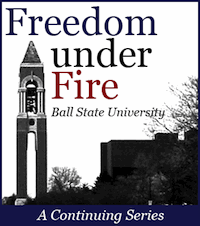 Education
Education
 Free Speech
Free Speech
Ball State University’s Dangerous Idea: Selective Academic Freedom
Courts generally don’t like it when public university administrators pick and choose which ideas are OK to talk about in class and which are not (i.e., selective Academic Freedom). But Ball State University (BSU) President Jo Ann Gora said “damn the torpedoes” anyway when on July 31, 2013, she promulgated a school-wide manifesto governing discussion of intelligent design, religion, and science.
Here are the high points:
- “Intelligent design is not appropriate content for science courses.”
- “Teaching religious ideas in a science course is clearly not appropriate.”
- “[W]hen religious ideas are appropriately taught in humanities and social science courses, they must be discussed in comparison to each other, with no endorsement of one perspective over another.”
 Why do it? Why hang these Three New Commandments on the gate of Ball State? The Freedom From Religion Foundation — basically four atheist lawyers in Madison, Wisconsin, who meanwhile are also trying to remove the Star of David from a proposed Holocaust memorial — sent Gora a vaguely threatening letter about intelligent design in an honors college class BSU offered to some students for science credit, taught by a well-liked physicist, Professor Eric Hedin. Gora then bravely folded like a lawn chair.
Why do it? Why hang these Three New Commandments on the gate of Ball State? The Freedom From Religion Foundation — basically four atheist lawyers in Madison, Wisconsin, who meanwhile are also trying to remove the Star of David from a proposed Holocaust memorial — sent Gora a vaguely threatening letter about intelligent design in an honors college class BSU offered to some students for science credit, taught by a well-liked physicist, Professor Eric Hedin. Gora then bravely folded like a lawn chair.
So design is out and so is one-sidedness on religion, right? Not quite. You can do both at Ball State so long as you do it the right way.
Like Dr. Hedin, Professor Paul Ranieri teaches an honors college seminar that focuses in part on the intersection of science and society. Unlike Hedin, Ranieri is an English teacher with no discernible background in science. No matter. Ranieri assigns materials that convey the right view on intelligent design, science and religion.
Below I’ve excerpted some of that righteousness from What Is Your Dangerous Idea?, the only book assigned in Ranieri’s syllabus.
Science Must Destroy Religion
Above is the title of one of the essays in the book assigned by Ranieri. You probably don’t need to read the essay to get the main idea.
Below is an honest-to-goodness paragraph from the book:
Religious faith — faith that there is a God who cares what name he is called, that one of our books is infallible, that Jesus is coming back to earth to judge the living and the dead, that Muslim martyrs go straight to Paradise, and so on — is on the wrong side of an escalating war of ideas.
And another:
The empirically testable idea that the here and now is all there is and that life begins at birth and ends at death is so dangerous that it has cost the lives of millions and threatens the future of civilization. The danger comes not from the idea itself, but from its opponents, those religious leaders and followers who ruthlessly advocate and defend their empirically improbable afterlife and man-in-the-sky cosmological perspectives.
And another:
Human beings are accidental and incidental products of the material development of the universe, almost wholly irrelevant an readily ignored in any general description of its functioning. Beyond Earth, there is no intelligence — however alien or like our own — that is watching out for us or cares. We are alone.
In case the book’s message is still not clear, there’s this (emphasis added):
Living creatures capable of reflecting on their own existence are a freak accident, existing for one brief moment in the history of the universe. There may be life elsewhere in the universe, but it does not have self-reflective consciousness. There is no God; no Intelligent Designer; no higher purpose to our lives.
And this:
Just as my patients adapt to difficult realities by creating metaphorical substitutes, it appears to me that beliefs in angels, deities and eternal souls can be understood in part as wish-fulfilling metaphors for an unpleasant reality that most of us cannot fully comprehend and accept.
And this:
The confrontation between science and formal religion will come to an end when the role played by science in the lives of all people is the same played by religion today… Imagine a Church of Latter-day Scientists, where believers could gather. Imagine congregations raising their voices in tribute to gravity, the force that binds us all to the earth and the earth to the sun and the sun to the Milky Way… One day the sites we hold most sacred just might be the astronomical observatories, the particle accelerators, the university research installations, and other laboratories where the high priests of science… engage in the noble pursuit of uncovering the workings of nature. And today’s museums, exposition halls, and planetaria may become tomorrow’s houses of worship.
So there you go. Religion bad. Science good. Anything religion can do, science can (and will, just you wait) do better. At Ball State, you are completely free to teach whatever you want as long as you want to teach this.
For more information about the double standards being applied at Ball State, read Discovery Institute’s new letter to BSU President Gora.
